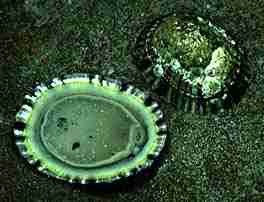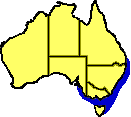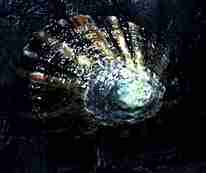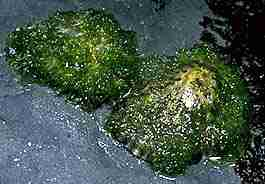|
|
Variegated Limpet Cellana tramoserica
Form:
 The
Variegated Limpet is oval shaped, slightly broader at the rear. Its apex
is not quite central. The sculpture
is of 36 strong, radial ribs
with many fine, encircling growth lines, which are close together.
The
Variegated Limpet is oval shaped, slightly broader at the rear. Its apex
is not quite central. The sculpture
is of 36 strong, radial ribs
with many fine, encircling growth lines, which are close together.
The margin is finely scalloped.
Notice that the distinct head bears the exploratory tentacles and feeding mouthparts of the overturned Variegated Limpet.
Some individuals from low on the shore may be quite large, thick and very tall. High on the shore, individuals may be quite flat and thin shelled. There is a great range in form.
Colour:
 There
is also a great variation in colour, hence its common name. In eastern
forms there is a conspicuous banding (see photo above), consisting of
many colours including brown, black, orange, yellow, pink and white. Usually
every third or fourth rib is darker, creating a striped pattern.
There
is also a great variation in colour, hence its common name. In eastern
forms there is a conspicuous banding (see photo above), consisting of
many colours including brown, black, orange, yellow, pink and white. Usually
every third or fourth rib is darker, creating a striped pattern.
In the southern form (see above right), this limpet is almost monotone in colour, being light brown with a fine speckled pattern. The eastern and southern colour forms are so different that they could be easily misidentified as separate species.
Phylum: |
Mollusca |
Author: |
Holten |
Family: |
Patellidae |
Size: |
50-60 mm in length, very variable |
Distribution:
 Ranges
from southern Queensland to eastern South Australia, including the east
coast of Tasmania.
Ranges
from southern Queensland to eastern South Australia, including the east
coast of Tasmania.
Habitat:
Occurs across a broad range of tide levels from the high water mark down. It is more common at the mid tide levels.
Biology:
 The
Variegated Limpet can tolerate a wide range of habitats and is found under
many conditions of exposure and dampness.
The
Variegated Limpet can tolerate a wide range of habitats and is found under
many conditions of exposure and dampness.
The Variegated Limpet has the ability to excavate a depression for itself in the rock and exhibits "homing" behaviour after feeding trips. It leaves a chemical trail on the outward journey which allows the limpet to find its way home.
If you try to pry a limpet off the rock, it will quickly clamp down, making it impossible for you to dislodge the limpet without damaging the shell. This is not a case of suction. The limpet uses its muscular foot to grasp imperfections on the rock surface.
This shell may also be very camouflaged when sea lettuce Ulva lactuca grows on its shell.
The Variegated Limpet feeds mainly on microalgae and the spores of larger algae. On southern shores the Sooty Oystercatcher is its main predator.
Questions:
 Do
all the Variegated Limpets look alike? Describe the various forms and
colour patterns.
Do
all the Variegated Limpets look alike? Describe the various forms and
colour patterns.
Look carefully where the various forms of the Variegated Limpet are living. What factors in the environment might affect the limpets shape or colour ?
Why can the algae grow on the limpet shell thickly, but not be common on the rock surface ?
References:
Also known as Cellana sontica, and Cellana variegata
Wilson & Gillett (3) 8 Macpherson & Gabriel (62)
Bennett, I. (1987) W.J. Dakin's classic study: Australian Seashores. p.235, Angus & Robertson, Sydney.
Davey, K. (1998) A Photographic Guide to Seashore Life of Australia. p.79, New Holland, Sydney.
Edgar, G.J. (1997) Australian Marine Life: the plants and animals of temperate waters. p.233, Reed Books, Kew.
Quinn, G.P., Wescott, G.C. & Synnot, R.N. (1992) Life on the Rocky Shores of South-Eastern Australia: an illustrated field guide. p.37, Victorian National Parks Association, Melbourne.
Marine Research Group of Victoria (1984) Coastal Invertebrates of Victoria: an atlas of selected species. p.29, Museum of Victoria, Melbourne.
Macpherson, J.H. & Gabriel, C.J. (1962) Marine Molluscs of Victoria. p.47, Melbourne University Press & The National Museum of Victoria.
Shepherd, S.A. & Thomas, I.M. (1982) Marine Invertebrates of Victoria, Pt.2 .p.550, South Australian Government Printer, Adelaide.
Underwood, A.J. & Chapman, M.G. (1993) Seashores: a beachcomber's guide. p.31, New South Wales University Press, Sydney.
Wilson, B.R. & Gillett, K. (1979) A field guide to Australian Shells: Prosobranch Gastropods. p.34, A.H. & A.W. Reed, Sydney.
Variegated
Limpet
Petterd's Limpet
Home
Page
Taxonomy
Biogeography
Rocky Shores
Tidal Levels
Intertidal Zonation
Environmental Factors
Biological
Factors
Feeding Relationships
Activities
Glossary
References
 Life
on Australian Seashores
Life
on Australian Seashores
by Keith Davey (C) 2000
Learning Consultant
- Media
The University of Newcastle
email at australian_seashores@hotmail.com
Scientific Consultant: Phil
Colman
site created 01.01.98 : updated 01.04.2000
